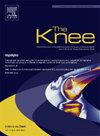供体-受体性别不匹配不影响同种异体膝关节骨软骨移植后移植物的存活
IF 2
4区 医学
Q3 ORTHOPEDICS
引用次数: 0
摘要
本研究旨在探讨供体-受体性别不匹配对同种异体膝关节骨软骨移植(OCA)后移植物存活、患者报告预后(PROs)和恢复运动(RTS)的影响。方法将2011年至2022年间接受膝关节OCA移植且至少有2年临床随访的患者分为同性(SS)和异性别(DS)供体两组。通过多变量Cox回归分析比较累积生存率,控制年龄、移植物大小和体重指数(BMI)。进行分组分析,比较各组之间的PROs,包括疼痛和满意度的视觉模拟量表(VAS)、膝关节损伤和骨关节炎结局评分(oos)和RTS率。结果共纳入285例患者(SS 189例,DS 96例),平均随访时间4.8±2.0年。DS组和SS组移植失败率为6.0%,移植存活率无显著差异(p = 0.70)。四种供体-受体组(男-男、女-男、男-女和女-女)之间以及女性和男性供体组之间的亚分析显示移植物存活无显著差异。在手术失败的患者中,移植物性别不匹配的患者失败的时间明显更短(353天vs 864天,p = 0.002)。对71例2年pro患者队列的亚分析显示,在控制性别后,SS组和DS组在满意度、疼痛或oos评分方面没有差异(p >;0.05)。结论膝关节OCA移植患者基于供体-受体性别匹配的移植物存活率无明显差异,提示外科医生可以使用性别不匹配的移植物,对移植物存活率的影响有限。证据等级:四级。本文章由计算机程序翻译,如有差异,请以英文原文为准。
Donor-recipient sex mismatch does not affect graft survivorship after knee osteochondral allograft transplantation
Background
This study aims to investigate the effect of donor-recipient sex-mismatch on graft survival, patient-reported outcomes (PROs), and return to sport (RTS) following knee osteochondral allograft (OCA) transplantation.
Methods
Patients who underwent knee OCA transplantation between 2011 and 2022 with minimum 2-year clinical follow-up were divided into two cohorts (same-sex (SS) and different-sex (DS) donor). Cumulative survival was compared via multivariable Cox regression analyses controlling for age, graft size, and body mass index (BMI). A sub-analysis comparing PROs between groups was performed, including the Visual Analog Scale (VAS) for pain and satisfaction, the Knee Injury and Osteoarthritis Outcome Score (KOOS), and RTS rates.
Results
285 patients were included (189 SS, 96 DS) with mean follow-up of 4.8 ± 2.0 years. There was a graft failure rate of 6.0% with no significant difference in graft survival rate between DS and SS groups (p = 0.70). Sub-analyses between the four donor-recipient groups (male-male, female-male, male–female, and female-female) and between female and male donor groups demonstrated no significant differences in graft survival. Among patients who failed the procedure, time to failure was significantly shorter for those with sex-mismatched grafts (353 days vs. 864 days, p = 0.002). Sub-analysis of a 71-patient cohort with two-year PROs demonstrated no differences between SS and DS groups with respect to satisfaction, pain, or KOOS scores after controlling for sex (p > 0.05).
Conclusion
Patients undergoing knee OCA transplantation demonstrated no observable differences in graft survivorship based on donor-recipient graft sex-matching, suggesting that surgeons can use sex-mismatched grafts and expect limited effect on graft survivorship.
Level of Evidence: IV.
求助全文
通过发布文献求助,成功后即可免费获取论文全文。
去求助
来源期刊

Knee
医学-外科
CiteScore
3.80
自引率
5.30%
发文量
171
审稿时长
6 months
期刊介绍:
The Knee is an international journal publishing studies on the clinical treatment and fundamental biomechanical characteristics of this joint. The aim of the journal is to provide a vehicle relevant to surgeons, biomedical engineers, imaging specialists, materials scientists, rehabilitation personnel and all those with an interest in the knee.
The topics covered include, but are not limited to:
• Anatomy, physiology, morphology and biochemistry;
• Biomechanical studies;
• Advances in the development of prosthetic, orthotic and augmentation devices;
• Imaging and diagnostic techniques;
• Pathology;
• Trauma;
• Surgery;
• Rehabilitation.
 求助内容:
求助内容: 应助结果提醒方式:
应助结果提醒方式:


